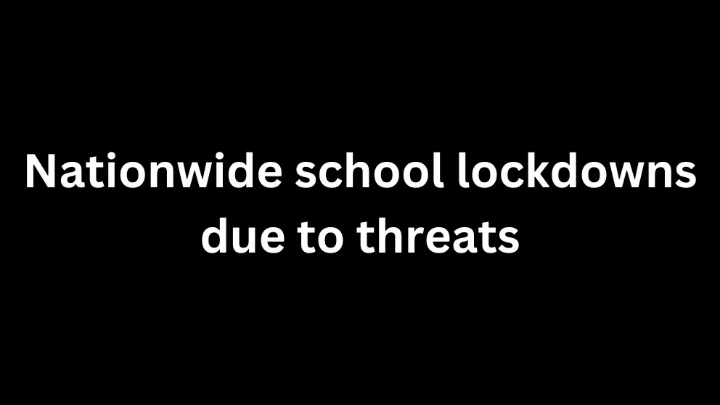
Schools Nationwide Shut Down Amid Surge of Threatening Emails About Potential Shootings
Schools across the nation have been compelled to enact lockdown procedures in response to a troubling surge of threatening emails received over the past several days. These incidents have not only disrupted the educational environment but have also instilled a pervasive sense of fear among students, parents, and educators alike. The threats communicated in these emails primarily revolve around the possibility of school shootings, a horrifying scenario that has unfortunately become all too familiar in recent years. The gravity of these threats has necessitated a rapid and coordinated response from educational institutions and law enforcement agencies to safeguard the well-being of everyone within the school community.
The content of these threatening emails has been described as highly alarming, with many explicitly referencing potential acts of violence or targeting specific schools. The nature of these threats has understandably caused significant anxiety, prompting schools to take immediate precautionary measures. These measures typically include initiating lockdown procedures, which involve securing all entry and exit points, keeping students and staff inside classrooms, and restricting movement within the school premises. Such protocols are designed to minimize risk and ensure that everyone remains safe while law enforcement agencies conduct their investigations.
The response to these threats has been swift, with local law enforcement agencies working tirelessly to investigate the origins and credibility of the emails. Law enforcement officials have been deployed to affected schools to provide a visible presence and reassurance to the school community. Their efforts include conducting thorough searches of school grounds, reviewing surveillance footage, and interviewing potential witnesses. In addition, law enforcement agencies are collaborating with federal authorities to trace the digital footprints of the individuals responsible for sending these threatening communications.
Despite these efforts, the situation has generated considerable concern about the possibility of copycat threats. Recent tragic events have heightened awareness and sensitivity around school safety, and there is apprehension that the current threats might inspire other individuals to imitate such behavior. Law enforcement officials have expressed their worries about the potential for a ripple effect, where one act of intimidation could lead to a series of similar threats. This concern has further underscored the need for vigilance and proactive measures to address and mitigate any emerging threats.
In response to the heightened threat environment, many schools have taken additional steps to bolster security measures. These steps include increased surveillance, enhanced communication protocols with parents and guardians, and coordination with mental health professionals to provide support to students who may be struggling with fear or anxiety. Schools are also working closely with community organizations and local authorities to ensure a comprehensive and collaborative approach to safety and security.
The impact of these threats extends beyond the immediate disruption of daily school activities. The emotional toll on students, teachers, and families cannot be underestimated. The fear and anxiety generated by such threats can affect the mental health and overall well-being of individuals within the school community. As a result, many schools are implementing support systems to help students cope with the stress and uncertainty associated with these incidents. Counseling services, support groups, and educational programs about safety and resilience are being offered to provide assistance during this challenging time.
The broader community response to these threats has also been significant. Parents and guardians have expressed their concerns and frustrations, demanding that measures be taken to ensure the safety of their children. Many have participated in meetings with school officials and law enforcement to discuss safety protocols and to seek reassurance about the steps being taken to address the situation. Community support has played a crucial role in reinforcing the collective effort to maintain a safe and secure educational environment.
Furthermore, the media coverage of these threats has contributed to raising awareness about the issue, but it has also brought additional scrutiny and pressure on the authorities involved. The portrayal of these incidents in the media can influence public perception and response, potentially amplifying fear or shaping the discourse around school safety. As a result, it is essential for all stakeholders to navigate this complex situation with sensitivity and care, ensuring that accurate information is communicated and that the focus remains on the safety and well-being of the school community.
In light of the ongoing investigations, law enforcement agencies are exploring various leads and employing advanced forensic techniques to identify the perpetrators. The use of technology, including digital forensics and cyber investigations, plays a critical role in tracing the sources of these threats and bringing those responsible to justice. The collaboration between different levels of law enforcement and intelligence agencies is crucial in addressing and resolving these incidents effectively.
The situation has also prompted discussions about the broader issue of school safety and the measures that can be implemented to prevent such threats in the future. Stakeholders are evaluating existing security protocols, considering new technologies, and exploring legislative measures that could enhance the protection of schools. The focus is on creating a more robust and resilient system to safeguard educational institutions against potential threats.
As the investigations continue and schools navigate these challenging circumstances, it is clear that a multi-faceted approach is necessary to address the issue comprehensively. The collaboration between educational institutions, law enforcement agencies, mental health professionals, and the broader community will be pivotal in ensuring that students and staff can return to a safe and secure learning environment. The experience underscores the need for ongoing vigilance, preparedness, and support in the face of evolving threats to school safety.
In conclusion, the recent wave of threatening emails has highlighted the critical importance of proactive and coordinated responses to ensure the safety of educational institutions. While the immediate focus is on addressing the current threats and supporting those affected, the experience also serves as a reminder of the ongoing need for vigilance and preparedness in safeguarding schools. The collaborative efforts of all involved parties will be essential in overcoming this challenge and restoring a sense of security within the school community.



